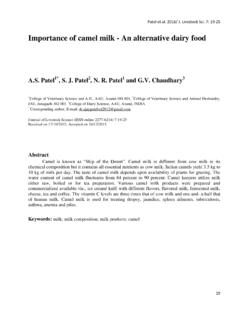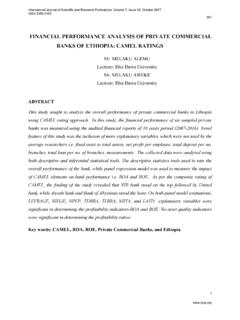Transcription of EFFECT OF CAMEL MILK ON GLYCEMIC CONTROL, RISK …
1 Agrawal, Swami, R. Beniwal, Kochar, Sahani, Tuteja and Ghouri (2003). EFFECT of raw CAMEL milk on GLYCEMIC control , risk factors and diabetes quality of life in type-1 diabetes: a randomised prospective controlled study. Journal of CAMEL Practice and Research 10(1): 45-50. EFFECT OF CAMEL milk ON GLYCEMIC control , RISK. FACTORS AND DIABETES QUALITY OF LIFE IN TYPE-1 DIABETES: A. RANDOMISED PROSPECTIVE CONTROLLED STUDY. Agrawal*, Swami, R. Beniwal, Kochar, Sahani, Tuteja and Ghouri Medical College and National Research Centre on CAMEL , Bikaner-334001, INDIA.
2 ABSTRACT. The efficacy of CAMEL milk on GLYCEMIC control risk factors and diabetes quality of life in patients of type 1 diabetes was evaluated. Twenty four randomly selected patients with type 1 diabetes were enrolled in the study. These patients were devided into two groups. Group 1 (N=12) received usual care (diet, exercise and insulin) and group 2 (N=12). received 500 ml CAMEL milk in addition to usual care for 3 months. Frequent blood sugar monitoring was done to maintain euglycemia by titrating the doses of insulin. HbA 1c, Lipid profile, plasma insulin and c-peptide estimation was done at the beginning and after 3 months.
3 BMI, diabetes quality of life questionnaire were prepared every week. In each visit patient was asked for any untoward effects after starting CAMEL milk . Baseline data of both the groups were similar in demographic and variables. After 3 months of treatment there were significant improvement in fasting blood sugar ( to ; p< ) and HbA 1c levels ( to 100 ; p< ) and significant reduction in insulin requirement (mean doses of insulin to 30 ;. p< )in patients receiving CAMEL milk . Diabetes quality of life score improved significantly in the form of change in satisfaction score from 28 to (p< ).
4 There was 30% reduction in doses of insulin in 92% of patients of group 2. However, there was no statistically significant changes in lipid profile, plasma insulin and c- peptide. CAMEL milk proved effective supplementation in the management of type 1 diabetes as there was significant reduction in doses of insulin along with betterment in BMI, diabetes quality of life however, there was no change in lipid profile and insulin levels. Key words: Alternative therapy, CAMEL milk , diabetes quality of life questionnaire, GLYCEMIC control , type 1 diabetes.
5 Type 1 diabetes mellitus is an organ specific auto immune disease, characterized by chronic hyperglycemia and disturbances of carbohydrates, fat and protein metabolism associated with insulin deficiency. Cow milk feeding induces primary immunisation to insulin in infants at generic risk for type 1 diabetes (Vaarela et al, 1999). The incidences if diabetes mellitus world wide appear to be increasing (Onkanoma et al, 1999). Prevention and early treatment is important because diabetes interrupts normal developments in children and carries the threat of severe complication in more active period of life (Dahlquist, 1999).
6 Its primary treatment is insulin replacement, however, at present, entire physiological insulin replacement can not be achieved in clinical practice and metabolic disturbances can not be normalised. Insulin therapy is still the best treatment but in our country needle phobia and cost of treatment forces these patients to adopt alternative treatments. In this connection we have heard many folklore stories which describe the use of CAMEL milk in type-1 diabetes mellitus. There is also an account in memories of Emperor Jahangir (1579.)
7 1627 AD) about usefulness and acceptability of CAMEL milk (Rogers, 1989). It is found that one of the CAMEL milk protein has many characteristics similar to insulin (Beg et al, 1986b) and it does not form coagulum in acidic environment (Wangoh, 1993). This lack of coagulum formation allows the CAMEL milk to pas rapidly through stomach together with the specific like protein/insulin and remains available for absorption in intestine. Radioimmunoassay of CAMEL milk has revealed high concentration of insulin 52 units/litre (Singh, 2001).
8 The concentration of insulin in human milk is also significantly higher ( micro u/ml) (Shehadeh et al, 2001) but probably because of coagulation in stomach it is not available for absorption in the intestine. -1- Agrawal, Swami, R. Beniwal, Kochar, Sahani, Tuteja and Ghouri (2003). EFFECT of raw CAMEL milk on GLYCEMIC control , risk factors and diabetes quality of life in type-1 diabetes: a randomised prospective controlled study. Journal of CAMEL Practice and Research 10(1): 45-50. Materials and methods Subjects A total of 24 type 1 diabetic patients were randomly recruited from the outpatient diabetic clinic in PBM Hospital, Bikaner, India.
9 Ethical committee of Medical College, Bikaner approved the protocol and subjects gave written constant before participation in the study. The patients were advised to follow strict diet, exercise and insulin treatment for 1 month. During this period frequent monitoring of blood sugar was done to maintain euglycemia. After one-month period these patients were again randomly divided into two groups. Group 1 patients (N=12) received usual care diet, exercise and insulin and the Group 2 patients (N=12) received 500 ml of CAMEL milk in addition to usual care for 3 months.
10 Patients with any acute metabolic complications like hypoglycaemia, ketoacidosis, cardiovascular event, renal or acute infections were not included in the study. Study Design an Analysis This was a randomised, open case control , parallel design study. Blood sugar was measured twice in a week before breakfast and before dinner and blood sugar concentration was measured using the glucose oxidase method. Plasma insulin and C-peptide were estimated by fully automated chemi-illuminescence (CLIA test). Anti-insulin antibodies were estimated by radioimmunoassay.







